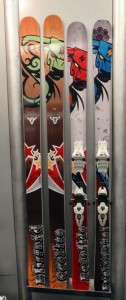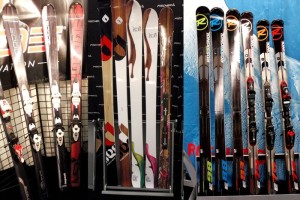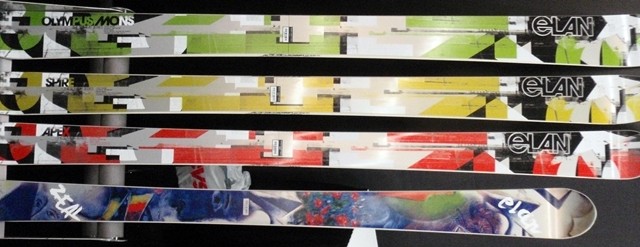Let’s start with the bad news first: If your skis are more than a few years old, you absolutely positively have to try some of the new skis on the market. And, yes, unless you are really stubborn or really poor, you probably ARE going to end up buying new skis.
The good news? It isn’t that your skis have gone downhill; it’s that the ski manufacturers have dramatically improved their understanding of how shaped skis work, and are producing skis that simply work better in ALL the vast and varied conditions you encounter on Eastern ski hills.
Choosing One Ski For The East

At EasternSlopes.com, we have, for many years, searched for the perfect “one ski quiver” for Eastern skiing. The operating thesis is that most skiers own one pair of skis, period…and that many who own several pairs take only one pair to the mountain on a given day, and then have to use those skis in dramatically changing conditions. Skiing in the East is all about adapting to change, and choosing one ski for the East means looking for maximum versatility
Powder day? With today’s emphasis on high capacity, high speed lifts you are lucky if you can get a Powder morning. Unless you are skiing the single chair at Mad River Glen, or it’s snowing all day long, by mid morning you are skiing “Chowder” (chopped-up powder) or powder bumps.
Groomed corduroy? After a few hundred skiers go over that trail, it’s a small mogul field with “hardpack” between the bumps. The steeper the trail, the faster the corduroy disappears.
Having a ski that can handle all conditions with aplomb means longer days of skiing, more enjoyment and less effort. And, given what ski tickets cost these days, aren’t more runs (with more fun) simply good economics?
Beyond that, there’s one major change in Eastern skiing in recent years: trees. Yes, the trees have always been there, and yes, there have often been some “official” glades, and yes, there have always been renegade skiers who poach powder out of bounds; but in the past half dozen years, areas have embraced letting skiers out into huge tracts of land to play. It wasn’t very long ago that areas like Jay Peak, Stowe and Mad River Glen proudly advertised the fact that they wouldn’t pull your ticket if they caught you skiing off the trails.
Now, all of a sudden, it’s the Wild West come East, a peculiar recipe that combines the best of both worlds–groomed slopes with lots of manmade snow, and natural snow skiing among the trees (with a LOT of manmade powder that blows off the trails into the trees to add depth!). But this combination of opportunities demands a lot from both skier and equipment if you want to take full advantage.
With that in mind, we went to the industry demo days at Loon Mountain on March 1 and 2 to test the latest and greatest in skis. Our goal was not necessarily to find “the ski; ” different skis suit different personal tastes and body types, and skiing styles differ. We usually can’t agree among ourselves which is “the best” ski in any test, let alone recommend one for you when we don’t know you or how and where you ski. Rather, we wanted to see if there were any trends that were making sense for the majority of skiers…and were we surprised!
Some background; the last time we did a full-on test of skis across multiple lines to see what the “one ski quiver” should be was 3 years ago at Stratton Mountain. The conditions were perfect for testing “all round” skis. Day one, we had groomed corduroy to start and scratchy boilerplate to end the day, so we were able to see how skis performed in less-than-ideal conditions. At about 6 that evening, it started to snow…and we woke up to 2 feet of powder and more coming down all day long. That narrow-waisted racer ski that was so much fun on Day 1? On Day 2, it sank out of sight. The big, fat “western style” ski that couldn’t put an edge in the hard stuff on Day 1 played around in the fluff on Day 2 like a dolphin at SeaWorld.
Ultimately, we came to the conclusion that the state-of-the-art for overall Eastern use was in skis that had a waist measuring between 73 and 78mm. Skis like the Volkl AC3 (and later AC30), the Blizzard Magnum 7.6 IQ, and the Fischer AMC 73 and its later iterations worked for us no matter what we tried (lighter testers loved the Fischers, heavier leaned toward the Volkls, and everyone loved the Blizzards). And, most of us put our money where our mouths were and updated our gear…it was hard to go back to our old boards after feeling the new ones.
Since then, though, the shift has been to wider skis, both underfoot and in the shovel and tail areas. And, “rocker” has appeared. Essentially, that refers to a ski that sits flat on the snow when unweighted, with the tips and tails up…think about the shape of a rocking chair’s base, and you’ve got the general, if exaggerated, idea. Rocker is intended to allow a ski to float up and over powder; it’s great in soft conditions, but how about in the varied conditions typical in the East?
That question brings up another point…why not just read ski tests, and buy what they recommend? The testers ARE experts, right? Well, yes, they are, and that’s part of the problem. An expert skier can make any ski do things that most skiers can’t; buy what they like, even if they say it’s for an intermediate or beginner skier, and you may hate it. Also, most ski tests are in unrealistic conditions. Take Ski Magazine’s testing for their 2011/12 buyer’s guide; in their own words, the conditions in Utah were “thigh-deep Wasatch powder, tracked thigh-deep Wasatch powder, corduroy.” Nary a mention of ice, slush, hard bumps. Soft western corduroy is what we in the East tend to call “hero snow”. ANY skier can look good and have fun; ANY ski can perform well. Wonderful…and if you ONLY ski when the conditions are like that, grab the ski they recommend. Oh, and be prepared to have no fun at all, as you may get only a couple of days of skiing in the whole winter. Better idea? Use the expert recommendations as a guideline, go to on-ski demo days or work with a shop that has a demo fleet, and, as you find skis that feel good to you in normal conditions, narrow your focus down to those and the ones similar to them.
You might, at this point, be asking “so, why should we be reading YOUR recommendations?” Good question, and easy answer. One, we actually test in Eastern conditions, and drag the skis into different situations. If we love a ski on corduroy, we immediately take it into the crud, the bumps and out into the glades if we can. Two, we’re not going to tell you what to buy; we want you to go out and actually test for yourself. Heck, it’s fun, and it’ll likely get you a ski that works right for YOU and make you a better skier as a bonus. Pay attention to that last part…the more skis you test and really try to find what feels right for you, the better you’ll be at recognizing the differences, and at being able to get the most out of whatever skis you are on.

Okay, on to the fun part…the skis. Two days at Loon Mountain, male and female skiers, various shapes and sizes and skill levels, and some fascinating results. Let’s deal with rocker first, as that’s the easy part. Based on our admittedly limited experience, for the typical Eastern skier that doesn’t live entirely in the trees or terrain parks, full rocker doesn’t appear to be a good idea. The characteristics that make it float up and over deep powder and give nice, gentle landings make it unstable in harder conditions. Effectively, on hard corduroy or boilerplate, you’re skiing on only a small part of the skis total edge under your foot; the rest of the ski tends to flop around and not make solid contact. We tested 190cm full-rocker skis that felt like ice skates underfoot; one tester commented: “I haven’t been that scared on skis in 20 years.” However, some rocker can be a good thing. A rockered tip allows the ski to easily move up and over deep piles of crud or flow through moguls; a rockered tail is great if you play in the woods and often need to move backwards out of dead-end spots that you’ve skied yourself into. Be aware, though, that if you choose a ski with rocker, you need a longer ski than otherwise in order to get the same performance in the hard conditions. Yes, that’s right; after years of skis getting shorter and shorter, new technologies are making skis get longer again!
Next comes the issue of ski width. Here’s the takeaway: wider HAS gotten better. Three years ago, skis in the 88-98 waist range were fun in the powder, but very difficult to get to “bite” in hard conditions. We all found them slow edge to edge, and tiring to ski. Even if we could make them perform well on hard snow, we had to work much too hard, which means short days of skiing. That’s no longer true. The majority of the skis that we tested in that range this time around were fun to ski! And, there wasn’t any specific “this width works best”; some 98s bit better than some 88s. Clearly, some manufacturers have gotten it better than others; and bizarrely enough, some of the most radical designs and most expensive skis from some of the biggest names were among the worst skis we tried. In fact, to a certain extent, expensive is the enemy of good in this category. Why? Because many manufacturers use “metal” in their top-of-the-line skis; in other words, a sheet of metal in the ski’s layup that adds stiffness. Great idea in narrow racing skis to reduce torsional twist; great for very heavy skiers, as well. For the average person who is trying to get a fat ski to bend, extra metal makes the ski feel like a board. Lesson to be taken from this: Don’t be afraid to try lower-end skis. The wider the ski you’re considering, the lower you should try in a manufacturer’s line before you buy. And, if you demo a ski and it’s way too stiff, ask if the same ski is available in a softer version; some manufacturers have virtually identical skis in different stiffnesses.

After pushing our physical and mental limits (when you’re used to a 73mm waist, it’s hard to believe that a 110mm can actually work on firm corduroy), here’s the consensus: Even the most hard-headed traditionalists among us admitted that if they had to buy a ski TODAY, with their hard-earned money, and were going to ski ALL Eastern conditions with it for the next three years, they wouldn’t consider anything narrower than 78mm at the waist. Most testers felt that while the narrower skis still were amazingly fun when pushed hard on hard surfaces, they’d likely end up with one of the skis in the 83-98mm range, with regular tree skiers more on the high end of the range.
What about even wider skis? We tried them. And, everyone agreed that while the skis above 100mm were often remarkable, when we removed the “wow, this works better than we expected!” factor, we found that…they didn’t work that well. They can certainly get down the mountain when necessary, and some could even be fun in fairly hard conditions, but as a day-in, day-out compromise they’re simply not a good choice for anyone other than utterly hardcore tree skiers. And, even some of those felt that going a bit narrower was a good compromise, allowing plenty of flotation while giving a greater safety margin when running into unexpected hardpack or, dare we say it, blue ice, deep in the glades.

Choosing One Ski For The East: Our final recommendations
1. Get to the first demo day you can. Be well rested and get there for first tracks, ready for a long day.
2. If you like a ski on the groomers, get it into the crud or the trees and see how it responds; you may be surprised in either a good or bad way.
3. Push a little beyond the familiar. If you think you’re a mainly “groomers only” skier and want a narrower waist ski for that, force yourself to try a wider ski anyway. You’ll learn more about yourself as a skier, appreciate the narrower ones even more, and you just might get a huge surprise and find that conditions that have made you nervous are now fun!
4. Once you have your new skis, take a lesson or two. Skiing technique has changed with the new ski designs, and the need for correct technique becomes even more important the wider the ski gets. You no longer need to shove your knee at the tip of the ski to try to bend it; now, you want to be more balanced, using both the tip and the tail to carve your turns, tilting the ski to the side to bend it rather than doing it with forward pressure.
Which, of course brings up another issue…boots. Tall, stiff boots with a lot of forward lean are out for non-racers; for the rest of us, a boot that has more fore/aft flex to allow you to work with the flex of the ski but is laterally stiff to transmit the tipping motion directly to the edge of the ski gets you more performance for less effort. That translates to more skiing, more control, less exhaustion, and much better use of your skiing dollar. Put it in perspective; a new pair of boots that will give you more skiing time for years can cost as little as the equivalent of a half dozen lift tickets; a cheap price to pay! Choosing a new boot doesn’t have to be a horrible process; follow the guidelines and work with a qualified bootfitter, and you may be surprised at how easy it is.
The bottom line is that, as we’ve often said, given how much each day of skiing costs you it’s worth making sure that your equipment allows you to get the most fun AND skiing time. And while we’re not fans of updating equipment too often (some of the pleasure comes from that connection with a familiar piece of equipment that allows you to not even THINK about what you have to do, but simply play), the fact is that ski technology has improved so rapidly that today’s skis allow you to handle more conditions more easily and with a lot more fun…and isn’t that why we’re all out there???



I’m pretty new to skiing but I feel like I “get it” and am progressing along nicely. Last year I purchased Salamon XW Storm skis and I really like them. But I happen to have a job which gives me access to amazing discounts on skis – and I’m looking at buying the Rossignol Experience 88 skis or the Atomic Crimson Ti skis – both 88mm under foot. I’ve read nothing but great things about them. But people in other forums seem to be trying to steer me more towards something wider under foot, but living in the northeast I think I would have little use for a ski with a 100mm under foot. I was thinking that the Atomic skis might be too advanced and stiff for me. Both happen to be considered expert level skis but I think the Rossignols are softer, more forgiving, easier to turn and generally good for intermediate through expert level. Anybody here happen to own these? Care to chime in?
Timothy-
Congratulations on the big discount…it’s nice to be able to play with new stuff! First, our general thoughts about ski width underfoot. Unless you’re going to be spending a LOT of time in the woods and virtually no time on groomed trails, we’d stick with the 88mm. We’re blown away by how well some of the wider skis work, but they also require better technique to make them carve, and as someone who is “pretty new to skiing”, better to have something a little more forgiving. We’ve skied deep powder enjoyably with skis as narrow as 76mm underfoot; it was harder work, but we could still float relatively well, and we did some skiing in Quebec’s Gaspe last year in waist-deep powder with skis that were 84mm underfoot and had a ball. The Rossignols, in particular, will float in virtually anything for you…they’re wider tip and tail than the Atomics (135-88-124 vs. 130-88-116), so have more surface area on the snow. when it’s deep, but still the same basic edge carve on harder stuff. We loved the Rossis in testing last year; even testers who generally don’t like the brand enjoyed them. So, we doubt you could go wrong with them; but, as always, individual tastes vary, so if you can, try before you buy!
Best,
David
Thank you very much for your timely input and advice David.
Yeah I’m going to take a chance on them without a demo. I’ve read nothing but good things about them. One guy said in a review that all you have to do is think turn and they turn! Another guy gave them 6 stars out of 5! I got a little OT over the holidays and I can probably get them for a price that I can’t walk away from. It’s a good gamble!
Can’t WAIT to get out there this year. Looks like if mother nature won’t cooperate with snow at least she’s starting to cooperate with somewhat consistent lower temps.